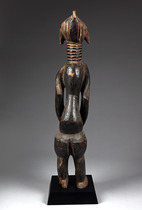Anthropomorphic figure "jagana" · Nigeria, Mumuye · ID: 3048877
UK Collection
Description
wood, kaolin, camwood powder, rest., base
Mumuye figures have different names depending on their region and function: “jagana” (“child of medicine”), “lagana” (“medicinal wood”), “sukp(w)a”, “janari”, “lapa”, etc.
Strybol reports that these figures were kept in special effigy huts (“jagalagana”). Such huts belonged to a person with an important function, i.e.a religious leader, a healer, a blacksmith, a rainmaker or a master of thunder or, more generally, a custodian of a cult seeking to preserve or restore balance in the society and among individuals.
Depending on the owners function, the figures can then be used to enhance prestige, to fend off evil, to cure all sorts of diseases, to predict the future, to spread the rain or to guard the family enclosure.
Strybol himself could observe how a Kudu diviner from around Sunkani took two “jagana” statuettes out of his effigy hut and laid them on the ground during a ritual to predict the future.
The object Anthropomorphic figure “jagana” with the object ID 3048877 was last part of the auction 98th Auction at March 26, 2022 on Zemanek-Münster Auction house. The object with the lot number 217 achieved a sales price of EUR 3,000.
You can find more Figures and other popular object types on our related topic pages. You may also be interested in our page on African art.
Comparing literature
Strybol, Jan, Art and the Sacred in Mumuyeland, Oostkamp 2018, p. 45, fig. 15








